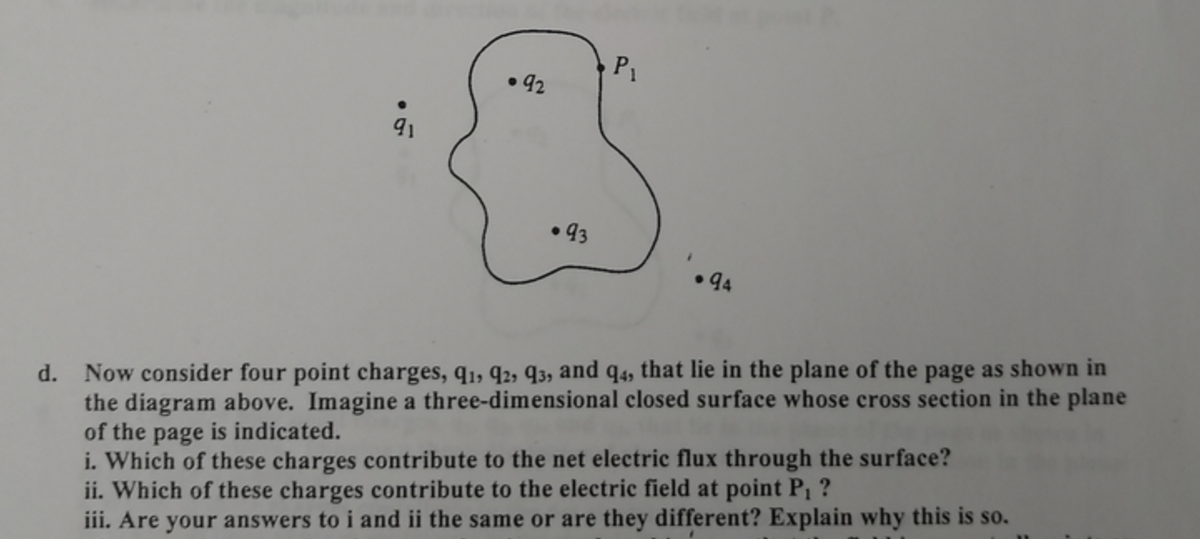Now consider four point charges, q1, q2, q3, and q4, that lie in the plane of the page as shown in the diagram above. Imagine a three-dimensional closed surface whose cross section in the plane of the page is indicated. i. Which of these charges contribute to the net electric flux through the surface? ii. Which of these charges contribute to the electric field at point P, ? iii. Are your answers to i and ii the same or are they different? Explain why this is so.
Now consider four point charges, q1, q2, q3, and q4, that lie in the plane of the page as shown in the diagram above. Imagine a three-dimensional closed surface whose cross section in the plane of the page is indicated. i. Which of these charges contribute to the net electric flux through the surface? ii. Which of these charges contribute to the electric field at point P, ? iii. Are your answers to i and ii the same or are they different? Explain why this is so.
Principles of Physics: A Calculus-Based Text
5th Edition
ISBN:9781133104261
Author:Raymond A. Serway, John W. Jewett
Publisher:Raymond A. Serway, John W. Jewett
Chapter19: Electric Forces And Electric Fields
Section: Chapter Questions
Problem 10CQ
Related questions
Question
Can you help me with part d of this homework its split into 3 parts but its technically one question

Transcribed Image Text:P1
•92
93
• 94
Now consider four point charges, q1, q2, q3, and q4, that lie in the plane of the page as shown in
the diagram above. Imagine a three-dimensional closed surface whose cross section in the plane
of the page is indicated.
i. Which of these charges contribute to the net electric flux through the surface?
ii. Which of these charges contribute to the electric field at point P ?
iii. Are your answers to i and ii the same or are they different? Explain why this is so.
Expert Solution
Step 1
i. Gauss Law of electrostatics states that the electric flux through any hypothetical closed surface (irrespective of its shape and size) is equal to times the net electric charge that the surface encloses.
Going by Gauss Law , charges q2 and q3 will contribute to the net electric flux through the surface.
ii) All the the charges (q1, q2, q3 and q4) will contribute to the electric field.
Electric field due to more than one charge is vector sum total of the electric field due to individual charges. We apply the principle of superposition.
Trending now
This is a popular solution!
Step by step
Solved in 2 steps

Knowledge Booster
Learn more about
Need a deep-dive on the concept behind this application? Look no further. Learn more about this topic, physics and related others by exploring similar questions and additional content below.Recommended textbooks for you

Principles of Physics: A Calculus-Based Text
Physics
ISBN:
9781133104261
Author:
Raymond A. Serway, John W. Jewett
Publisher:
Cengage Learning


Physics for Scientists and Engineers, Technology …
Physics
ISBN:
9781305116399
Author:
Raymond A. Serway, John W. Jewett
Publisher:
Cengage Learning

Principles of Physics: A Calculus-Based Text
Physics
ISBN:
9781133104261
Author:
Raymond A. Serway, John W. Jewett
Publisher:
Cengage Learning


Physics for Scientists and Engineers, Technology …
Physics
ISBN:
9781305116399
Author:
Raymond A. Serway, John W. Jewett
Publisher:
Cengage Learning